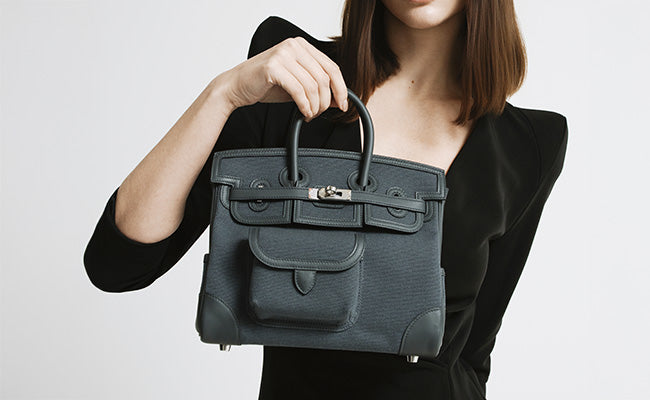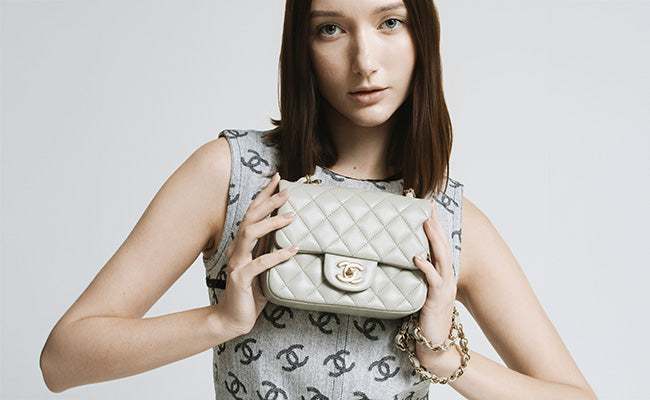
Birkin Bag Myths Debunked: Common Misconceptions Explained
Check out our Hermès collection and Birkin bags!
The Hermès Birkin bag is probably the most misunderstood luxury item out there. Between wild price rumors and made-up buying rules, the internet has turned this already exclusive bag into something almost mythical.
Most of what you think you know about buying or even understanding Birkin bags is likely off-base. Those dramatic tales of years-long waiting lists and strict spending requirements? They're mostly exaggeration. These myths don’t just confuse people, they could actually mess up your chances of scoring the bag if you take them at face value.
Let's cut through the noise and clear up the biggest Birkin myths. We’ll look at how you really get one, what they actually cost, how they’re made, and why people want them so badly. The truth might surprise you.
Key Takeaways
- Most Birkins cost about $11,000–$12,000, not $30,000 as you often hear
- There aren’t official waiting lists anymore, and you don’t always need a big purchase history
- Each bag takes 18–25 hours for one artisan to make, these aren’t churned out in a factory
Myth #1: Birkin Bags Are Easy to Buy
Despite what you might hear, buying a Birkin bag from Hermès isn’t easy. The brand ditched their old waiting lists, but that doesn’t mean you can just stroll in and buy one.
The Illusion of Waiting Lists
A lot of people think you can just hop on a waiting list and eventually get your dream Birkin. It’s not that straightforward.
Hermès actually scrapped their big waiting list system years back. There’s no official list tracking who gets which bag next.
What really happens:
- Sales associates might jot down your preferences
- No one promises you’ll actually get a bag
- Associates don’t know what’s coming in future shipments
So, instead of a neat line, you’ve got a game of timing and luck. It’s less about patience and more about being strategic.
Behind Closed Doors: Hermès Buying Process
Buying a Birkin at Hermès is a bit of a mystery compared to other luxury shopping experiences. Sales associates have a lot of control over who gets offered which bags.
Most standard leather Birkins (30cm or 35cm) go for around $11,000 to $12,000 in North America. That $30,000 number you see everywhere? That’s mostly for rare exotics.
Deliveries from Paris are unpredictable. Associates really don’t know what’s coming, so they can’t promise you a specific bag.
What affects your odds:
- How many tourists are in town
- When deliveries happen (it’s random)
- Your relationship with the staff
- How quickly inventory moves
Sometimes, a lucky shopper just walks in at the right moment and walks out with a Birkin, especially in busy tourist cities.
Shopping History and Relationships Matter
You might hear you have to build up a purchase history to get a Birkin, but that’s not the whole story. Relationships do matter, though.
If you connect with a sales associate at a particular boutique, you’re more likely to get a call when something special arrives.
Why shopping history helps:
- Staff recognize you
- You might get first dibs on new arrivals
- Better service, more attention
- Sometimes, you get inside info
But plenty of first-timers still get lucky, especially tourists who just happen to show up at the right time.
Honestly, being genuinely interested in Hermès beyond just the Birkin helps a lot. Staff can spot a “bag hunter” a mile away, and they usually respond better to real enthusiasm.
Myth #2: Birkin Bags Are Mass-Produced
Birkins are about as far from mass-produced as you can get. Every single Hermès Birkin is crafted by hand, start to finish, by one artisan.
Handcrafted by Hermès Artisans
A single Hermès craftsperson brings each Birkin to life. These artisans train for years before they’re trusted with such a project.
It all starts with hand-picked leather. No machines cutting out cookie-cutter pieces here.
Every artisan stamps their own code inside the bag, so you can trace each one back to its maker.
Stitching is a whole art form. Hermès uses a saddle stitch, two needles working through each hole at once. It’s way tougher than machine stitching.
Even the hardware gets hand-polished and fitted, piece by piece.
Time Required to Make a Birkin
Making a Birkin takes anywhere from 12 to 25 hours. There’s no assembly line here.
The exact time depends on the leather and size. Crocodile and other exotics take even longer.
One person makes the whole bag. They don’t hand it off down a line.
Prepping the leather alone can eat up hours. Each piece gets checked for flaws before cutting.
Stitching takes real patience. If you rush, the quality nosedives.
This time commitment is why Hermès makes so few bags compared to other luxury brands.
Personal Touches & Individuality
No two Birkins are truly identical, even if they’re the same color and size. Leather varies naturally, so each one’s unique.
The artisan’s personal touch shapes tiny details. Their stitch rhythm, their hand pressure, it all leaves a mark.
Every hide has its own grain and quirks. What would be a “flaw” in mass production is character here.
Bags age differently, too. Each leather reacts to use and time in its own way.
That craftsman’s stamp inside? It’s their signature, literally. Some collectors even prefer bags by certain artisans.
Myth #3: Birkin Bags Were Always Famous
A lot of people think the Birkin has been a big deal since it debuted in 1984. Actually, it took years, and some pop culture magic, to become the icon we know today.
From Obscurity to Icon Status
When Hermès made the first Birkin for Jane Birkin in 1984, it didn’t set the world on fire. For a long time, it stayed a secret among fashion insiders.
Jane Birkin herself treated her bag like a regular carryall. She’d stuff it with her things and use it daily, it was hardly treated like a museum piece.
Back then:
- Production was tiny
- Hermès barely promoted it
- Only people deep in the fashion world paid attention
- Its reputation spread slowly, mostly by word of mouth
Through the late ‘80s and early ‘90s, the Birkin was more of a “fashion secret” than a mainstream status symbol.
The Sex and the City Effect
Everything changed when Samantha Jones dropped that classic line about needing a Birkin on Sex and the City in 2001. Suddenly, millions of viewers saw the bag as the ultimate status symbol.
After that, the Birkin wasn’t just a fancy handbag, it became a pop culture trophy. The show made it seem so exclusive that even the rich and famous had to hustle to get one.
Around that same time, celebrity culture exploded. Suddenly, photos of Victoria Beckham or Paris Hilton with a Birkin were everywhere.
What followed:
- Magazines ran features on celebrity Birkin collections
- Media hyped up the bag’s exclusivity
- Waitlists at Hermès grew
- Resale prices shot up
Social media only added fuel to the fire, taking the Birkin from fashion-world secret to full-blown obsession.
Myth #4: The Birkin Bag Is Just Another Designer Purse
The Birkin isn’t just another expensive designer bag. Its story starts with a real-life encounter between Jane Birkin and Hermès CEO Jean-Louis Dumas, and its design comes straight from the brand’s equestrian roots.
Origins: The Jane Birkin & Jean-Louis Dumas Story
The Birkin’s origin story almost sounds made up, but it happened on an Air France flight in 1983. Jane Birkin, the British-French actress, found herself next to Jean-Louis Dumas, Hermès’ CEO.
When Birkin’s straw bag spilled all over the aisle, she complained to Dumas about not having a practical yet stylish leather weekend bag. She wasn’t just making small talk, she actually needed something that worked for her life.
Dumas listened, grabbed a napkin, and started sketching. He got what Birkin wanted: something functional but elegant.
They made the first prototype just for Jane Birkin in 1984. That original bag? It recently sold for $10.1 million at Sotheby’s. Not exactly your average designer purse.
Distinctive Design Elements
The Birkin stands out not just for its price, but for the insane level of craftsmanship. One artisan makes each bag, spending 18 to 24 hours on it.
The bag has two rolled handles, not a single strap, so you carry it by hand or in the crook of your arm, not over the shoulder.
Other signature touches:
- Padlock and keys (clochette) come with every bag
- Four little metal feet on the bottom
- Double-stitched seams using that signature saddle-stitch
- Hand-painted, burnished edges
The closure is unique, no zippers or snaps. Instead, leather straps wrap around and through the hardware, a nod to Hermès’ equestrian gear.
Hermès' Equestrian Influence
You can’t really understand the Birkin without knowing Hermès’ horsey roots. Founded in 1837 as a harness and saddle maker, Hermès still draws on that tradition.
The Birkin’s construction uses the same saddle-stitching they use for saddles, these seams get stronger with time, not weaker.
Hermès sources its leather from tanneries that supply equestrian equipment, so the bags are built to last.
Even the hardware echoes bridles and stirrups. Those metal pieces aren’t just for looksthey’re inspired by real horse tack.
Every Birkin carries that sense of heritage, making it a totally different beast from bags designed just to look good on Instagram.
Myth #5: All Birkins Are Equally Rare and Expensive
Not all Birkins are created equal. There’s a massive difference between a standard leather Birkin and, say, a diamond-studded Himalaya.
The Himalaya Birkin: The Ultimate Rarity
The Himalaya Birkin sits at the top of the luxury bag pyramid. Made from rare albino Niloticus crocodile, it’s dyed to look like the Himalayan mountains.
What really sets it apart? Its 18-karat white gold hardware, covered in diamonds. Hermès only makes a few a year, and only the most elite clients ever get offered one.
Prices start at $150,000 and can go well over $500,000. The most expensive Birkin ever? A Himalaya, of course.
This isn’t just a bag, it’s art, and its value keeps climbing.
Materials, Sizes, and Special Editions
Regular Birkins in Togo or Epsom leather usually start at $10,000 to $15,000. But if you want exotics, get ready for sticker shock.
Crocodile Birkins run from $30,000 to $80,000, depending on the type and size. The Touch Birkin (regular leather with exotic accents) goes for $30,000 to $60,000.
Special editions are in a league of their own:
- Faubourg Birkin: $90,000–$150,000
- So Black Birkin: $30,000–$80,000
- Diamond Birkin: $200,000–$400,000+
Size plays a role, too. The 25cm and 30cm bags are more sought-after, and pricier than the bigger 35cm or 40cm versions.
Legendary Auction Prices
Auction houses have turned into battlegrounds for rare Birkins, with prices blasting past retail by wild margins. Christie's and Sotheby's keep putting Birkin auctions on the map, and the numbers just keep climbing.
Take the Himalaya Birkin, for example, it’s become a record-breaker. In 2022, someone dropped over $400,000 for one at auction. That’s more than a house in plenty of places.
Even discontinued models like the So Black or Ghillies Birkin pull in serious cash. Club Birkins have gone for $35,000, though they originally retailed for around $20,000.
Limited runs and exotic materials push these bags into investment territory. Some people see them as appreciating assets, outpacing plenty of traditional investments.
Myth #6: Everyone Wants a Birkin for the Same Reasons
It’s easy to assume all Birkin fans are after the same thing, but honestly, that’s just not true. Some folks chase financial returns, others want a bag that feels like them, and plenty care about the cultural story or passing something special down.
Investment Value vs. Personal Style
The numbers don’t lie. Certain Hermès Birkin combos have outperformed traditional investments over the years. Rare colours, think Rouge H in crocodile, or those quirky seasonal releases can skyrocket in value.
But you know what? A lot of collectors aren’t chasing profit. They’re on the hunt for that one shade of blue that just clicks with their wardrobe. You’ll see their bags decked out with charms and accessories, totally personalized.
Investment-minded buyers usually stick to the classics: black, gold, étoupe, and they like the 30cm or 35cm sizes. Style-first buyers go for bolder colours or unusual leathers that fit their vibe.
You can spot the difference in how they use their bags. The investors keep everything pristine, original packaging and all. The style fans? They’ll carry theirs everywhere.
Pop Culture and Social Status
Celebrity culture has changed the Birkin game. Some people want the exact bag they saw on a celebrity. Others use it as a status symbol, proof they’ve made it.
Social media only adds fuel to the fire. Check out the #BirkinBag hashtag: younger buyers love showing off, while seasoned collectors keep things more low-key.
Those chasing status pick the flashiest options, bright colours, exotic leathers, something that screams luxury. They want everyone to notice.
Pop culture fans might look for bags tied to specific moments or celebrity stories. The Jane Birkin connection? That still draws in buyers who care about the bag’s artistic roots.
Collector Communities and Legacy
Serious collectors do things differently. They track production numbers, obsess over leather grains, and even build relationships with Hermès craftspeople. For them, each bag is a piece of art and history.
A lot of collectors think long-term. They’ll buy with their daughters or grandkids in mind, seeing Birkins as future heirlooms, sentimental and financial value rolled into one.
Some just love the craft. They respect the hours of work that goes into each bag and often own several Hermès pieces, knowing the ins and outs of every leather type.
And then you’ve got the completists, people who want every size in a colour, or every leather available. For them, it’s about the thrill of a complete collection, not just a single bag.
Frequently Asked Questions
The Birkin world is packed with questions, from investment basics to the mysteries of buying one. Let’s dig into the most common ones about price, access, value, and quality, these come up all the time in luxury circles.
Are Birkin bags really worth the investment, or is it all just a luxury hype train?
Birkin bags usually hold their value, and sometimes even beat their original retail price on the resale market. The mix of limited supply, incredible craftsmanship, and the Hermès name gives them real scarcity, not just hype.
Still, calling any luxury bag a surefire "investment" feels a bit off. Condition, size, colour, and leather type matter a lot.
The standard 30cm and 35cm Birkins in regular leathers tend to do well. Exotic leathers and limited editions? They’re the ones that really shoot up in value.
Can anyone just walk into an Hermès store and buy a Birkin, or is there a secret handshake involved?
You can walk into an Hermès boutique and, if luck’s on your side, buy a Birkin, no special handshake required.
Sales associates decide who gets offered a bag, but they do sell Birkins to first-timers, especially if you show up on the right day. Places with lots of tourists see this a lot.
It’s more about timing and luck than any secret ritual. Building a relationship with a sales associate might help, but it’s not mandatory.
Is it true that you have to be on a VIP list to even glance at a Birkin in real life?
Hermès got rid of official waiting lists years ago, so the "VIP list" thing is outdated. There’s no secret registry.
If you’re a regular, a sales associate might remember your preferences, but that’s not the same as a formal list. It’s mostly about what’s in stock and when you walk in.
Plenty of Birkins go to walk-in customers who just happen to be there at the right time.
Do Birkins actually appreciate in value, or is that just wishful thinking by glitterati?
Birkins do tend to appreciate, but how much depends on the details. Rare colours, exotic leathers, and discontinued styles usually see the biggest jumps.
Standard leather Birkins in popular sizes keep their value, and often go for more than retail. Limited editions and crocodile versions can really soar.
Of course, market trends, bag condition, and authenticity checks all play a part. Appreciation isn’t a guarantee, but the track record for well-kept, real Birkins is solid.
They say a Birkin bag's quality is unmatched, but does it really outshine other luxury brands?
Hermès sets the bar high with hand-stitching and top-notch materials, and that’s a big part of their reputation. Each bag takes hours of work by a single artisan.
Leather quality, sturdy hardware, and careful construction really do make Birkins stand out. That said, some other luxury brands come close in craftsmanship.
Calling them "unmatched" is a bit subjective, but Hermès consistently lands near the top for quality and materials in the luxury bag world.
Is the notion that Birkins are better with age just a sweet old tale, or is there some truth to it?
If you look after Hermès leather, it really does get better as the years go by. The leather picks up a unique character and softens, and that patina? It’s what a lot of collectors actually want.
Vintage Birkins in great shape can fetch higher prices, mostly thanks to this aged leather vibe. The bags feel softer but still hold their shape.
Of course, you’ve got to care for and store them right, but aging seems to do these bags a favor. There’s a whole crowd out there hunting for Birkins that have that lived-in, developed look.




